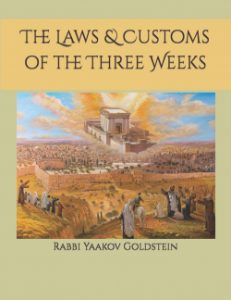Visiting the Kosel/Western Wall:
It is customary of Jews throughout the generations to visit the Western wall found in the old city of Jerusalem, which is formally known as the Kosel. The Midrash states that the Western Wall will never be destroyed.[1] The Shechina never departed from the Western Wall even after the destruction and will remain there forever.[2]
What is the Western Wall?[3] The Western Wall is a wall of the Temple Mount, Har Habayis and not of the Heichal, Azara, or Beis Hamikdash itself.[4] It is therefore permitted to visit the Western Wall even though we remain in a state of impurity, and so is the custom of all Jewry for many generations. [Some Poskim[5] however are stringent in this matter, and would not visit the Western Wall.]
May one touch the stones of the Western Wall and enter notes into it? Some Poskim[6] rule one is to abstain from touching the stones of the Kosel, or entering notes into it.[7] The majority of Poskim[8] however rule it is permitted to do so, and so is the widespread custom.[9] Even according to the first opinion, if one immersed in a Mikveh prior to visiting, it is permitted to enter the fingers into the stones.[10]
|
_____________________________________________
[1] Shir Hashirim Raba 2:63; Tana Dvei Eliyahu 30
[2] Eicha Rabasi 1:31; Shemos Raba 2; Radbaz 648; Zohar Shemos 5b; Hayom Yom 21st Tamuz; See Yeshuos Yaakov on Tana Dvei Eliyahu ibid
[3] See Ir Hakodesh Vehamikdash 4:2; Igros Moshe O.C. 2:113 “Certainly this area where people customarily Daven contains a tradition from the Rishonim that it is permitted to go there, and thus how can one argue on them”
[4] Avnei Nezer 450; Tiferes Tzevi Y.D. 27:12; Mishkanos Leabir Yaakov in name of Maharil Diskin and Rav S.Z.Z of Lublin; Ir Hakodesh Vehamikdash 4:2; Tzitz Eliezer 10:1; Yabia Omer 5:27; Piskeiy Teshuvos 561:6
Other opinions: Some Poskim considered the Western Wall as the wall of the Azara/Beis Hamikdash, [Radbaz 2:691] This opinion has been negated by almost all Gedolei Yisrael, and archeologists. See Ir Hakodesh Vehamikdash ibid; Igros Moshe O.C. 2:113
[5] Some Poskim considered the Western Wall as the wall of the Azara/Beis Hamikdash, [Radbaz 2:691; Shaareiy Tzedek 11:8; Poskim brought in Ir Hakodesh Vehamikdash ibid; Igros Moshe O.C. 2:113 that so was custom of the Brisker Rav top not visit the Western Wall] which would mean that Har Habayis begins much earlier, into which a Tamei person may not enter. [See Piskeiy Teshuvos 561:6]
[6] Mishkanos Leabir Yaakov [Adart]; See Ir Hakodesh Vehamikdash 4:50 for a lengthy discussion on this matter and how even if we accept the notion that the Kosel contains the Kedusha of Har Habayis, it would only be forbidden for one who did not Toivel to enter his fingers there. Furthermore, he does not accept the novelty of the Adart that even touching would be forbidden
[7] The reason: As perhaps the actual wall of the Har Habayis has the same Kedusha as the Har Habayis, and if so, one who is Tamei from Zav, Baal Keri, Nidda or Yoledes, cannot enter his fingers there.
[8] Avnei Nezer 450; Tiferes Tzevi Y.D. 27:12; Mishkanos Leabir Yaakov in name of Maharil Diskin and Rav S.Z.Z of Lublin; Ir Hakodesh Vehamikdash 4:2; Tzitz Eliezer 10:1; Yabia Omer 5:27; Piskeiy Teshuvos 561:6
The opinion of the Rebbe: It is recorded that the Rebbe inquired into this matter on numerous occasions upon having visitations from Gedolei Yisrael in Eretz Yisrael. On one occasion, the Rebbe is said to have told a Chassid that he should stick the note into the wall using a stick. [See Hiskashrus 259 and 261] It is told that when the Rebbe Rayatz visited Eretz Yisrael in the year 5688 he inquired as to whether people kiss the Kosel wall, and after the affirmative reply, he went ahead and kissed the wall. See Sefer Hasichos 5688 p. 25. All in all, in 1971, the Rebbe instructed the Shluchim to write a Petekl when they visit the Kosel, and include in it their names, as is the custom. [Toras menachem Vol. 64 p. 158] No mention however was made regarding entering it into the wall.
[9] The reason: As in truth the walls of Har Habayis do not contain the Kedusha of Har Habayis. [ibid]
[10] See Ir Hakodesh Vehamikdash ibid



Leave A Comment?
You must be logged in to post a comment.